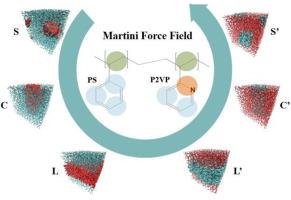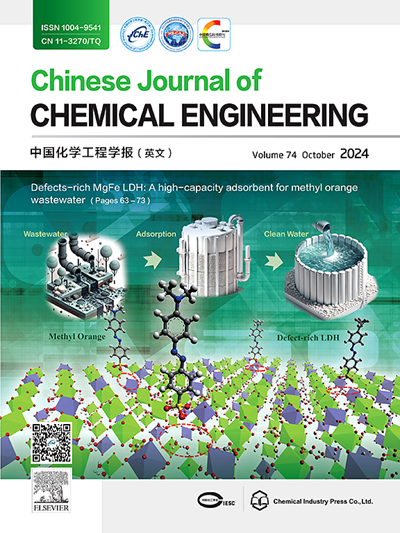聚苯乙烯-嵌段聚(2-乙烯基吡啶)自组装的粗粒度分子动力学模拟
IF 3.7
3区 工程技术
Q2 ENGINEERING, CHEMICAL
引用次数: 0
摘要
嵌段共聚物(bcp)的自组装非常复杂,需要大量的实验和模拟工作来揭示它,以最大限度地提高结构秩序和设备性能。粗粒度(CG)分子动力学(MD)模拟提供了一个微观角度来观察bcp的自组装。虽然在CG过程中牺牲了一些分子细节,但该方法具有显著的计算效率。本研究构建了聚苯乙烯-嵌段聚(2-乙烯基吡啶)PS-b-P2VP的综合CG模型,并利用全原子MD模拟得出的目目值对参数进行了优化。PS-b-P2VP是研究最广泛的bcp之一,具有高Flory-Huggins相互作用参数。CG模型与实验中观察到的各种经典自组装形态完全吻合,符合理论相图。此外,我们的模拟结果也清楚地揭示了实验相图的构象不对称性,模拟得到的相界与实验结果高度一致。CG模型有望扩展到模拟除PS-b-P2VP之外的其他bcp的自组装行为,从而从分子水平上增加对bcp微相分离的理解。本文章由计算机程序翻译,如有差异,请以英文原文为准。

Coarse-grained molecular dynamics simulations on self-assembly of polystyrene-block-poly(2-Vinylpyridine)
Self-assembly of block copolymers (BCPs) is highly intricate and is adsorbing extensive experimental and simulation efforts to reveal it for maximizing structural order and device performances. The coarse-grained (CG) molecular dynamics (MD) simulation offers a microscopic angle to view the self-assembly of BCPs. Although some molecular details are sacrificed during CG processes, this method exhibits remarkable computational efficiency. In this study, a comprehensive CG model for polystyrene-block-poly(2-vinylpyridine), PS-b-P2VP, one of the most extensively studied BCPs for its high Flory-Huggins interaction parameter, is constructed, with parameters optimized using target values derived from all-atom MD simulations. The CG model precisely coincides with various classical self-assembling morphologies observed in experimental studies, matching the theoretical phase diagrams. Moreover, the conformational asymmetry of the experimental phase diagram is also clearly revealed by our simulation results, and the phase boundaries obtained from simulations are highly consistent with experimental results. The CG model is expected to extend to simulate the self-assembly behaviors of other BCPs in addition to PS-b-P2VP, thus increasing understanding of the microphase separation of BCPs from the molecular level.
求助全文
通过发布文献求助,成功后即可免费获取论文全文。
去求助
来源期刊

Chinese Journal of Chemical Engineering
工程技术-工程:化工
CiteScore
6.60
自引率
5.30%
发文量
4309
审稿时长
31 days
期刊介绍:
The Chinese Journal of Chemical Engineering (Monthly, started in 1982) is the official journal of the Chemical Industry and Engineering Society of China and published by the Chemical Industry Press Co. Ltd. The aim of the journal is to develop the international exchange of scientific and technical information in the field of chemical engineering. It publishes original research papers that cover the major advancements and achievements in chemical engineering in China as well as some articles from overseas contributors.
The topics of journal include chemical engineering, chemical technology, biochemical engineering, energy and environmental engineering and other relevant fields. Papers are published on the basis of their relevance to theoretical research, practical application or potential uses in the industry as Research Papers, Communications, Reviews and Perspectives. Prominent domestic and overseas chemical experts and scholars have been invited to form an International Advisory Board and the Editorial Committee. It enjoys recognition among Chinese academia and industry as a reliable source of information of what is going on in chemical engineering research, both domestic and abroad.
 求助内容:
求助内容: 应助结果提醒方式:
应助结果提醒方式:


